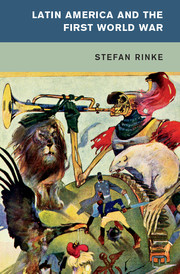Book contents
- Frontmatter
- Contents
- List of Figures
- Preface
- List of Abbreviations
- Introduction
- 1 The Global Context before 1914
- 2 Neutrality under Pressure, 1914-1917
- 3 In the Wake of War, 1917
- 4 Turbulent Paths into a “New Era,” 1918-1919
- 5 The Demise of a World
- 6 Nation and Trans-nation
- Epilogue: The Global Legacy of the World War
- Sources and Literature
- Chronology
- Index
5 - The Demise of a World
Published online by Cambridge University Press: 09 March 2017
- Frontmatter
- Contents
- List of Figures
- Preface
- List of Abbreviations
- Introduction
- 1 The Global Context before 1914
- 2 Neutrality under Pressure, 1914-1917
- 3 In the Wake of War, 1917
- 4 Turbulent Paths into a “New Era,” 1918-1919
- 5 The Demise of a World
- 6 Nation and Trans-nation
- Epilogue: The Global Legacy of the World War
- Sources and Literature
- Chronology
- Index
Summary
The confrontation with the First World War in Latin America went far beyond the exclusive spheres of the diplomats or the elites involved in the propaganda war. In Latin America, the war was above all a highly mediatized event. Although the upper classes produced most of the available sources, these sources nevertheless show that the conflict had an astonishingly wide social impact in many parts of Latin America, especially in its urban areas. These developments attest to changes in perceptions about the world, which were at once immediately connected to, but also greatly transcended, the reception of the war's progress and its tangible repercussions. As a “global media event,” the war affected the global consciousness of many Latin Americas. Through news reports and their own firsthand experience, they developed a stronger sense of the entanglements and the various dependencies that impacted their region of the world. In discussing the war, Latin Americans participated what for the first time became a global public sphere. A form of symbolic delimitation took place that radically reduced, if not entirely eliminated, the distance between the region and the battlefields. The war was thus also a world war because it permeated the everyday lives of many Latin Americans.
THE WAR IN EVERYDAY LIFE
In the Latin American press, the outbreak of the war in August 1914 was the event that overshadowed everything else and filled up the gazettes’ columns. In Latin America's urban centers, the reports could reach a huge audience because the newspaper industry had experienced a genuine explosion in the 1910s. Unlike in the nineteenth century, their readership was by no means limited to members of the national elites, but rather also increasingly attracted readers from the working class and the growing middle class. Even in civil-war-torn Mexico, newspapers like the El Imparcial already had full-page spreads on the events in Europe on August 1. The cables from the news services in Europe followed in rapid succession. The reports, however, did not stay current for even a day and there was a voracious appetite for the latest news. Consequently, the papers in Buenos Aires printed three, sometimes even four, editions daily. Innumerable photographs depicting modern weaponry, military maneuvers, and the European aristocracy heightened interest.
- Type
- Chapter
- Information
- Latin America and the First World War , pp. 195 - 225Publisher: Cambridge University PressPrint publication year: 2017

